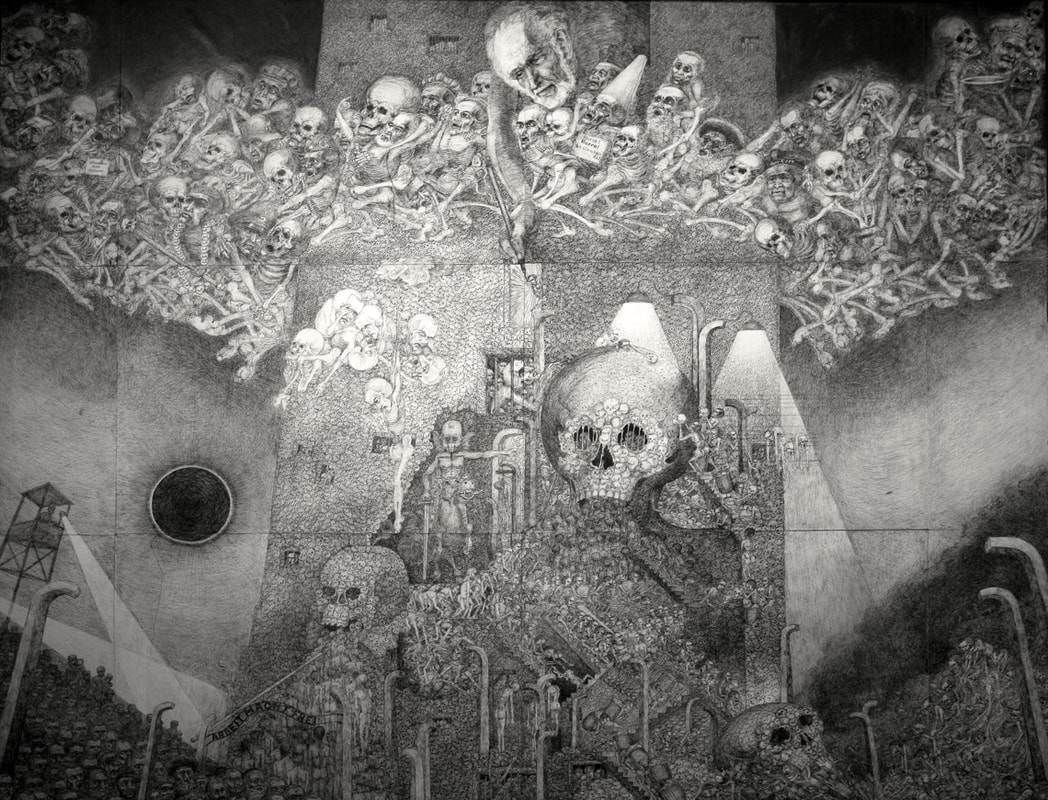Memory, art, love, and hell collide as an Auschwitz survivor finally confronts the
horrors of his past after 50 years of silence.
|
“I built Auschwitz because I arrived there in the first transport. It was also true that for almost fifty years I did not speak about Auschwitz. But nevertheless throughout that whole time Auschwitz was present in everything I did.” -Marian Kołodziej
|
About Marian Kołodziej
Marian Kolodziej was on one of the first transports to enter Auschwitz. He was given number 432. He survived and never spoke of his experience for 50 years. After a serious stroke in 1993, he began rehabilitation by doing pen and ink drawings depicting the experiences he and others endured in the concentration camp. These drawings, in their skeletal detail, are a gripping depiction of the pain, death, and horrors of the camp. While most of the drawings represent the memories of a young man’s hellish experiences in Auschwitz, some tell stories of small acts of kindness and dignity.
Marian’s story of survival, of persistence, of life before, during, and after Auschwitz are a testament to the human spirit. Marian’s drawings and art installations, which he called The Labyrinth, fill the large basement of a church near Auschwitz and draw visitors into the horrific reality of the holocaust.
'This is not an exhibition, nor art. These are not pictures. These are words locked in drawings…I propose a journey by way of this labyrinth marked by the experience of the fabric of death…It is a rendering of honor to all those who have vanished in ashes.' -Marian Kolodziej
Marian’s story of survival, of persistence, of life before, during, and after Auschwitz are a testament to the human spirit. Marian’s drawings and art installations, which he called The Labyrinth, fill the large basement of a church near Auschwitz and draw visitors into the horrific reality of the holocaust.
'This is not an exhibition, nor art. These are not pictures. These are words locked in drawings…I propose a journey by way of this labyrinth marked by the experience of the fabric of death…It is a rendering of honor to all those who have vanished in ashes.' -Marian Kolodziej
SYNOPSIS
In The Labyrinth, Marian takes the audience on a journey through his drawings and art installations. Through the blending of his testimony and the graphic drawings, we explore the memories and nightmares of a man, who like so many others buried experiences deep within. Why would a confrontation with death late in life, trigger the need to record his long-suppressed memories? And why in this graphic, metaphorical way? This documentary raises these questions in a visually stunning way.
Marian was in the same roll call and cell block as Fr. Maximilian Kolbe, who voluntarily took the place of a prisoner condemned to death and was subsequently executed. This self-less act became legendary in Auschwitz and inspired the entire camp---somehow an act of love and courage stood as a testament to good in the face of overwhelming evil. Marian’s numerous drawings of Kolbe are stark and iconographic. Kolbe is now a saint in the Catholic Church.
This is eyewitness testimony that is unique in the annals of documenting the Holocaust. Marian is a Polish Catholic, who has used his drawings to give testimony to the horrors of Auschwitz and of the world today, and whose body of work provides a testament to suffering and ‘man’s inhumanity to man.’
Marian was in the same roll call and cell block as Fr. Maximilian Kolbe, who voluntarily took the place of a prisoner condemned to death and was subsequently executed. This self-less act became legendary in Auschwitz and inspired the entire camp---somehow an act of love and courage stood as a testament to good in the face of overwhelming evil. Marian’s numerous drawings of Kolbe are stark and iconographic. Kolbe is now a saint in the Catholic Church.
This is eyewitness testimony that is unique in the annals of documenting the Holocaust. Marian is a Polish Catholic, who has used his drawings to give testimony to the horrors of Auschwitz and of the world today, and whose body of work provides a testament to suffering and ‘man’s inhumanity to man.’
CONTACT US
For more information about The Labyrinth or to purchase a DVD, please contact us HERE.
